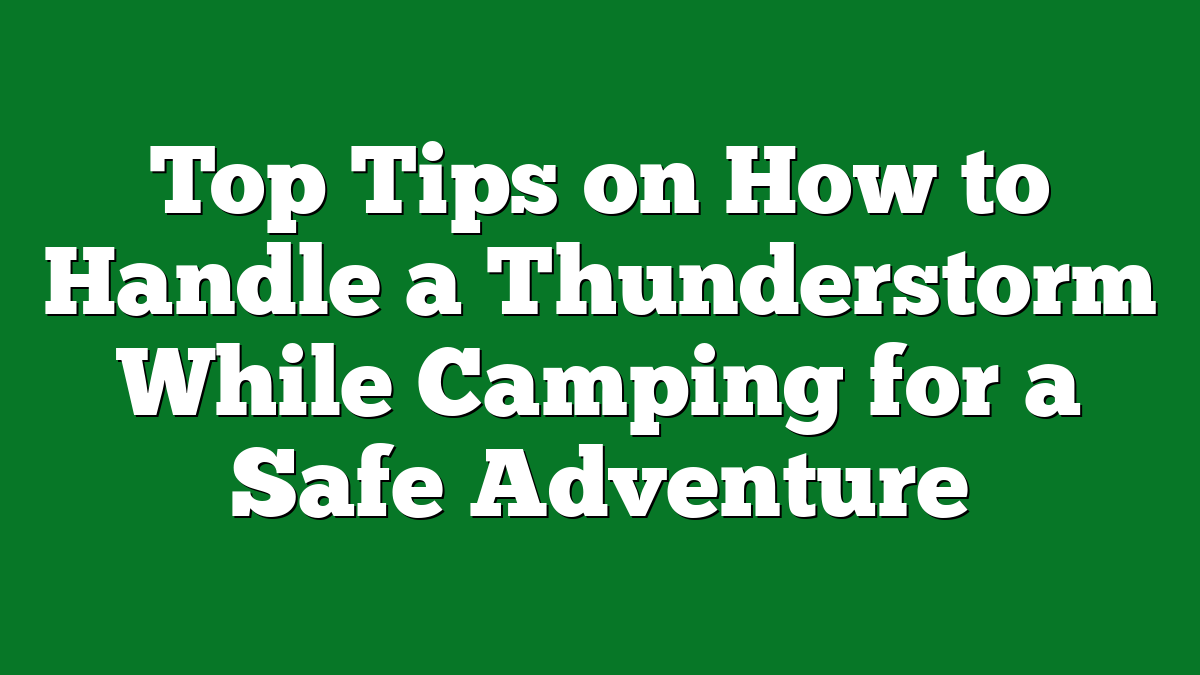There’s nothing quite like the thrill of camping under the stars, but when a thunderstorm rolls in, that excitement can quickly turn to anxiety. I’ve been there, huddled in my tent, listening to the wind howl and the rain pound down. It’s a moment that tests our preparedness and adaptability in the great outdoors.
Knowing how to handle a thunderstorm while camping can make all the difference between a memorable adventure and a scary experience. With the right tips and tricks, you can stay safe and even find a way to enjoy the stormy weather. So let’s dive into some essential strategies to keep you and your gear protected when nature throws a curveball your way.
Understanding Thunderstorms
Thunderstorms can be unpredictable and intense, especially while camping. Knowing their causes and signs helps prepare me for sudden changes in weather.
What Causes Thunderstorms
Thunderstorms form when warm, moist air rises and cools. This cooling leads to condensation, creating clouds and droplets. As these droplets combine, they grow heavier and fall as rain. Updrafts can develop, causing turbulence and leading to the potential for lightning, hail, and strong winds. The ingredients for a thunderstorm include humidity, instability, and a lifting mechanism, such as a front or terrain disturbances.
Identifying Thunderstorm Signs
Recognizing the signs of an approaching thunderstorm can keep me safe. Here are several indicators to watch for:
- Darkening Clouds: Cumulonimbus clouds (towering and dark) appear ominously in the sky.
- Increasing Wind: Sudden gusts of wind signal a change in weather conditions.
- Temperature Drop: A noticeable drop in temperature might signify an impending storm.
- Static Electricity: If I notice static on my hair or my skin tingles, it suggests that lightning might occur soon.
- Thunder Sounds: The increasing rumble of thunder, especially if it grows louder, indicates a storm’s nearness.
By staying alert to these signs, I can better prepare for thunderstorms while enjoying everything the great outdoors offers.
Preparing for Camping in Thunderstorm-Prone Areas
Preparation makes a big difference in how I handle thunderstorms while camping. Knowing what to do before heading out ensures a safer experience.
Choosing the Right Campsite
Choosing the right campsite is crucial. I look for areas away from tall trees and slopes. Setting up my tent in a low-lying area can minimize water pooling. Staying clear of dry riverbeds and creeks prevents flash flooding. I always pick spots that allow for quick shelter access if a storm hits.
Packing Essential Gear
Packing essential gear helps me stay safe during a storm. I never forget a waterproof tent with strong stakes to withstand high winds. Heavy-duty tarps and rope come in handy for extra coverage and protection. A good pair of waterproof boots keeps my feet dry, while extra clothing layers prevent hypothermia. I always include a reliable flashlight and batteries for visibility, plus a first-aid kit ready for emergencies. Lastly, having portable charging devices ensures my communication gear stays powered.
Safety Tips During a Thunderstorm
Experiencing a thunderstorm while camping can be daunting, but following simple safety measures helps keep everyone safe and comfortable in tough conditions.
Seeking Shelter
Finding appropriate shelter is crucial during a thunderstorm. I look for sturdy structures like visitor centers or cabins when available. If not, I set up my waterproof tent, ensuring it’s pitched away from potential hazards like tall trees and steep slopes. In a pinch, I can also utilize natural cover, such as rock formations or thick forests, but I always stay vigilant to avoid areas where lightning could strike.
Protecting Yourself from Lightning
Lightning poses a serious risk during a thunderstorm. I minimize my chances of being struck by avoiding open areas. If I can find a vehicle, I stay inside with all windows closed. If I’m out in the open, I crouch down with my feet together and hands covering my ears, reducing my profile while on low ground. Staying away from metal objects and water sources is essential too, as they can attract lightning.
Staying Dry and Warm
Staying dry and warm during a storm helps maintain comfort and prevents hypothermia. I pack quality rain gear and wear moisture-wicking layers to trap warmth. Inside my tent, I make sure to keep clothes dry and store extra layers within easy reach. Keeping a high-quality sleeping bag and insulating ground pad also ensures I stay warm as temperatures drop. Using tarps over the tent helps deflect rain and maintains a dry living space.
Post-Thunderstorm Considerations
After a thunderstorm passes, taking the time to carefully assess your campsite and surroundings is crucial. Storms can cause unexpected changes in the environment, so examining your area for safety ensures a smoother continuation of your camping adventure.
Assessing Damage to Your Campsite
First, I check for any damage around my campsite. I look for fallen branches, uprooted trees, and impacted tents. Inspect my gear for leaks or tears and assess the stability of my tent setup. If rainwater has pooled nearby, I make a mental note of which areas to avoid going forward. It helps to move my gear away from any potential hazards, especially if the ground feels unstable.
Continuing Your Camping Trip Safely
Next, I focus on resuming my camping activities. I ensure my camping stove is dry and ready for use, then I prepare a warm meal to recharge my energy. Staying hydrated is equally important, so I refill my water supply if needed. Before resuming any hikes or fishing outings, I listen closely to the weather forecast to avoid being caught off guard again. If conditions are still unstable, I may choose to spend extra time relaxing at the campsite, enjoying the fresh, cleansed air. Ultimately, embracing the lessons learned from the storm enhances my camping experience, preparing me for whatever nature throws my way.
Conclusion
Camping during a thunderstorm can be daunting but it doesn’t have to ruin your adventure. By staying prepared and knowing how to react, you can turn a potentially scary experience into an unforgettable one. I’ve learned that embracing the storm can actually deepen my appreciation for nature’s power.
Remember to keep an eye on the sky and trust your instincts. With the right gear and a solid plan, you’ll be ready for whatever comes your way. So next time you hear the rumble of thunder, take a deep breath and enjoy the wild beauty around you. Happy camping!











